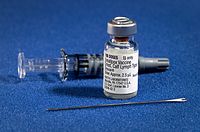
Photo from wikipedia
Globally, parasites are increasingly being recognized as catastrophic agents in both aquaculture sector and in the wild aquatic habitats leading to an estimated annual loss between 1.05 billion and 9.58… Click to show full abstract
Globally, parasites are increasingly being recognized as catastrophic agents in both aquaculture sector and in the wild aquatic habitats leading to an estimated annual loss between 1.05 billion and 9.58 billion USD. The currently available therapeutic and control measures are accompanied by many limitations. Hence, vaccines are recommended as the “only green and effective solution” to address these concerns and protect fish from pathogens. However, vaccine development warrants a better understanding of host–parasite interaction and parasite biology. Currently, only one commercial parasite vaccine is available against the ectoparasite sea lice. Additionally, only a few trials have reported potential vaccine candidates against endoparasites. Transcriptome, genome, and proteomic data at present are available only for a limited number of aquatic parasites. Omics-based interventions can be significant in the identification of suitable vaccine candidates, finally leading to the development of multivalent vaccines for significant protection against parasitic infections in fish. The present review highlights the progress in the immunobiology of pathogenic parasites and the prospects of vaccine development. Finally, an approach for developing a multivalent vaccine for parasitic diseases is presented. Data sources to prepare this review included Pubmed, google scholar, official reports, and websites.
Journal Title: Vaccines
Year Published: 2021
Link to full text (if available)
Share on Social Media: Sign Up to like & get
recommendations!